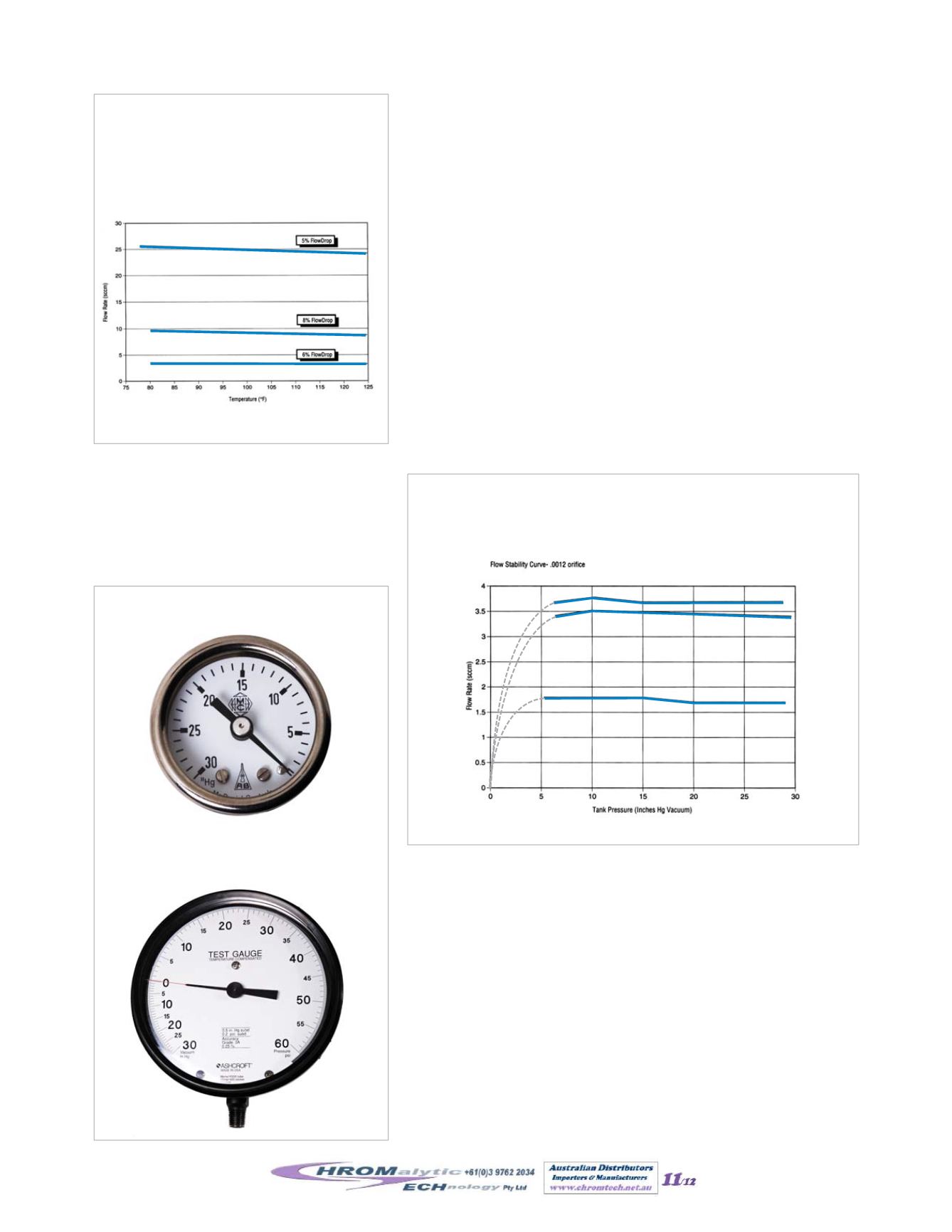
4
•
800-356-1688
upstreamof aconstantbackpressure.This constantbackpressure is established
by the balance between themechanical spring rate of the diaphragm and the
pressuredifferential across thediaphragm.The latter is establishedby thepres-
sure difference between the atmospheric pressure, the vacuum in the canister,
and the flow through the critical orifice.Thenet result is a constant flow.
The critical orificedetermines the flow range.The adjustablepiston is used to
set a specific, fixed flow ratewithin the flow range.An adjustment to theposi-
tion of the piston changes the back pressure, which changes the pressure dif-
ferential across the critical orifice. If the piston is lowered away from the
diaphragm, the flow rate will increase. If the piston is raised toward the
diaphragm, the flow rate will decrease. This flow controller will accurately
maintain a constant flow despite changes in vacuum over a range of -30"Hg
to -7"Hg. Flow is constant until the vacuum range of the device is exceeded,
making the flow controller unable tomaintain the constant pressure differen-
tial. In Figure 6, for example, the flow rate is constant from -29.9" Hg to
approximately -7"Hg, atwhichpoint the flow rate decreases because the flow
controller is unable tomaintain the proper pressure differential. This control
will allow theuser to collect approximately5 liters of sample in a6-liter canis-
ter. This is an extremely important factor in obtaining valid time-integrated
samples through passive sampling.We will discuss this point further in the
FieldSampling
(SectionV) of this guide.
FieldSamplingandLaboratoryVacuumGauges
A vacuum gauge as shown inFigure 7A enables samplingpersonnel to visually
monitor changes in thevacuum in thecanisterduring sampling. If the flow rate
changes unexpectedly (e.g., due to a leak or an incorrect setting), the vacuum
gaugewill indicateadisproportionatelyhighor lowvacuum in thecanister,and
correctiveactioncanbe taken (i.e., flowadjusted) in time toensureavalid sam-
ple. This type of vacuum gauge is attached to the sampling train for use in the
field. The vacuum gauge should be of high quality to ensure that it does not
introduce contaminants into the sample.All wettedparts in the vacuum gauge
areconstructedof stainless steel;Restekgauges areaccurate towithin1%of full
scale.Onceused for sampling, agaugemust be cleaned, and shouldbe certified
clean.Procedures aredescribed later in this guide.
Tomonitorpressure in the canisterbeforeandafter sampling,useamoreaccu-
ratemeasuringdevice. For example, test gauges built byAshcroft®, as shown in
Figure7B, are accurate to0.25%of full scale.These sensitive gauges shouldnot
beused in the field—they typically arewallmounted in the lab.
Courtesy of Veriflo Corp., a division of Parker Hannifin Corp.
Figure6
A flow controllerwillmaintaina constant sample flow
until it isunable tomaintaina stablepressuredifferential across
the critical orifice.
DifferentialPressureResponse
Figure7A
FieldSamplingGauge
Figure7B
HighAccuracyLaboratoryGauge
Figure5
A flow controllerwillmaintaina
constant sample flowdespite changes in
canister pressureor environmental
temperature.
TemperatureEffects
Courtesy of Veriflo Corp., a division of Parker Hannifin Corp.
Website :
E-mail :
TelNo : 03 9762 2034 . . . inAUSTRALIA


